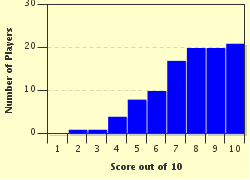Quiz Answer Key and Fun Facts
1. The countries of Haiti and the Dominican Republic can both be found on the Caribbean's second largest island. By what name, derived from one given to it by Christopher Columbus, is it now known?
2. Which Dutch island in the Lesser Antilles shares its name with a liqueur flavoured with the peel of the laraha fruit?
3. The Caribbean Community (CARICOM), a group formed by various Caribbean nations and dependent territories, was set up by the Treaty of Chaguaramas in 1973. Which of the original four signatories is NOT a Caribbean island nation?
4. Which British Overseas Territory, located approximately 500 km (310 miles) north-west of Jamaica, is named after a species of the genus Crocodylus?
5. The Caribbean Sea and its many island nations are located on the Caribbean tectonic plate. What name is given to the trench that marks part of the boundary between the Caribbean plate and the North American plate and contains the deepest point of the Atlantic Ocean?
6. Bequia, Canouan, Carriacou and Mustique are all located in which island chain (part of the Windward Islands) whose ownership is divided between two independent nations?
7. Pico Duarte, the highest point on any Caribbean island, is located in the Cordillera Central mountain range in which country?
8. Many of the islands in the Lesser Antilles were named after various saints following their discovery by European explorers, but to which country do the islands of Saint Thomas, Saint John and Saint Croix belong?
9. Tourism is one of the major contributors to the economies of Caribbean island nations and grew massively during the 20th century as a result of improved transport links and the development of the 'package holiday'. However, the Caribbean's first hotel aimed squarely at tourists opened in the late 18th century on which island that was then a British colony?
10. On which Caribbean island can you find the Soufriere Hills volcano which erupted in 1995 destroying the town of Plymouth and resulting in the southern half of the island being designated as an exclusion zone?
Source: Author
Fifiona81
This quiz was reviewed by FunTrivia editor
Tizzabelle before going online.
Any errors found in FunTrivia content are routinely corrected through our feedback system.


